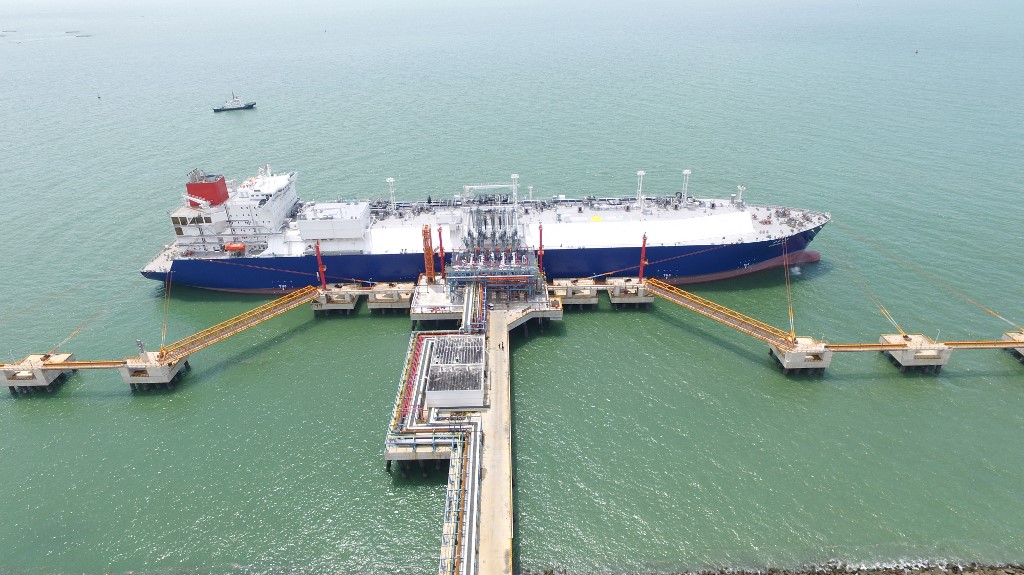Gas company for the Chinese capital is seeking LNG for an import terminal it is building in Tianjin; the gas will be mainly distributed to urban areas in and around Beijing, as China cuts its use of coal for power production
(AF) Beijing Gas Singapore, the trading unit of Beijing Gas Group, on Monday invited expressions of interest for liquefied natural gas (LNG) suppliers from 2023 to 2032, according to a notice posted on the Shanghai Petroleum and Natural Gas Exchange. Interested suppliers are required to submit proposals by July 2.
The company is seeking supply for a new LNG import terminal, with a capacity of 5 million tonnes per annum (mtpa), it is building in the northern Chinese city of Tianjin. Beijing Gas is adding the terminal to a list of other facilities to help serve the Bohai Rim region. The area includes two major municipalities – Beijing, Tianjin – and three provinces – Hebei, Shandong and Liaoning – areas that consume the most natural gas in China.
The LNG terminal has eight 220,000 cubic metre (cu m) LNG storage tanks, along with two 200,000 cu m LNG storage tanks, and is scheduled to commence operations late next year, the company says.
Currently, there are five LNG receiving terminals located in the Bohai Rim region with a total LNG receiving capacity of 30 mtpa, according to commodities data provider S&P Global Platts.
Beijing Gas is mainly engaged in urban gas distribution and supplies over 10 billion cubic metres (bcm) of gas to Beijing, comprising more than 50% of the city’s total gas demand.
The firm’s LNG supply tender marks the extent of China’s ongoing LNG infrastructure build-out as the country seeks to use the fuel to replace an over-reliance on dirty burning coal, mostly in its power production sector. Gas, for its part, emits around 50% less CO2 emissions than coal when used for electricity power generation.
China’s LNG pivot
China has said that gas should make up at least 10% of the country’s energy mix by 2020, and 15% by 2030, with further earmarks after that. However, given Chinese President Xi Jinping’s pledge last September to a virtual UN audience that the country would reach net zero carbon emissions by 2060, while capping emissions by 2030, gas’ percentage of the country’s energy mix could increase even more.
The Beijing Gas disclosure also shows how China is poised to pass Japan as the top global LNG importer by as soon as next year. In early 2019, China slipped past South Korea to take the second slot.
Since then, China has been building out its LNG infrastructure at a record pace. It now has as many as 22 LNG receiving terminals of various sizes, mainly on its eastern seaboard, with more in the works.
As such, China is already the major force in LNG spot markets in the region.
The Asia-Pacific accounts for two-thirds of global LNG demand and that percentage is set to increase over the rest of the decade amid growing Chinese procurement, more Indian LNG demand, particularly post-Covid-19, and increasing demand from newer LNG players such as Pakistan, Bangladesh, Sri Lanka, the Philippines, Vietnam and Thailand.
This increase in demand will intersect with even more supply entering the market, mostly amid more US and Russian liquefaction capacity, and especially from Qatar toward the end of the decade.
By developing its massive North Field East further, state-run Qatar Petroleum will increase the country’s liquefaction capacity from 77 mtpa currently to 110 mtpa by 2026 and a record-breaking 126 mtpa by 2027.
Australia, for its part, which recently moved past Qatar with 80 mtpa worth of capacity to be the second largest exporter, could possibly become the third highest source in the mid-term if more US projects reach final investment decisions over the next several years. That, however, depends on more Chinese investment and supply deals, which may not materialize given the more than two-year trade war between Beijing and Washington.
China will also take advantage of this global production ramp-up by pivoting away from its current reliance on Aussie LNG.
Two weeks ago, Beijing verbally ordered the country’s so-called second-tier LNG importers to stop buying the fuel for at least the rest of the year. Though these smaller buyers only make up about 10% of China’s LNG imports from Australia, it marks an increase in diplomatic hostilities between the two countries, and also shows Beijing’s intent on pivoting away from Aussie LNG.
However, that pivot will take time and effort given that Australian producers supply some 40% of China’s LNG, mostly on long-term contracts signed by oil majors such as CNOOC, with the balance on the spot market, which now represents around one-third of total volumes traded in northeast Asia.
During the more than year-long diplomatic stand-off between Beijing and Canberra, mostly over Canberra’s call for an investigation into the origins of the coronavirus, Beijing has increasingly targeted numerous Aussie imports, with both official and unofficial bans, including coal, barley, copper, wine, lobster, meat products and timber.
China will also pivot to more piped gas from neighbouring countries. Shortly after Beijing banned Aussie LNG imports for second-tier buyers, mostly city-gas distributors, it reinvigorated gas supply talks with Turkmenistan.
Turkmenistan is the second largest country in Central Asia. Though it is a landlocked country that shares borders with Iran, Afghanistan, Uzbekistan and Kazakhstan, it is playing a key role in China’s Belt and Road ambitions.
ALSO SEE:
China turns to Turkmenistan for gas, thumbs nose at Australia
























